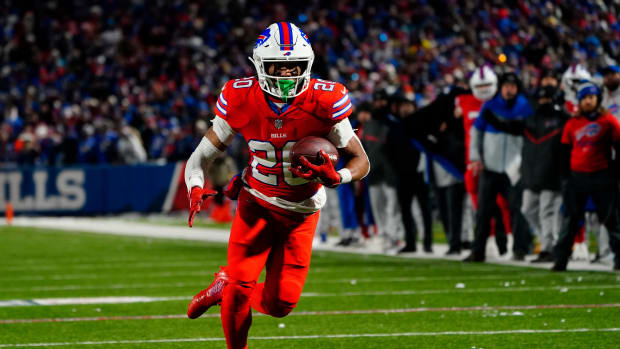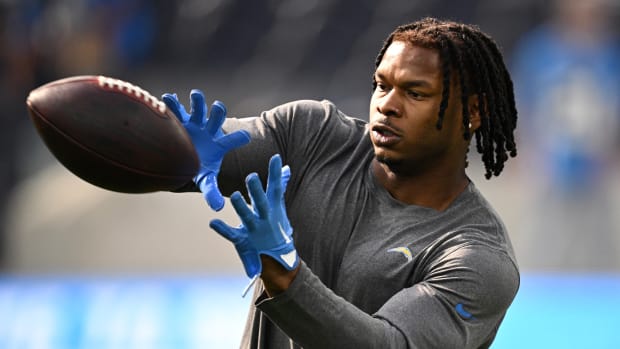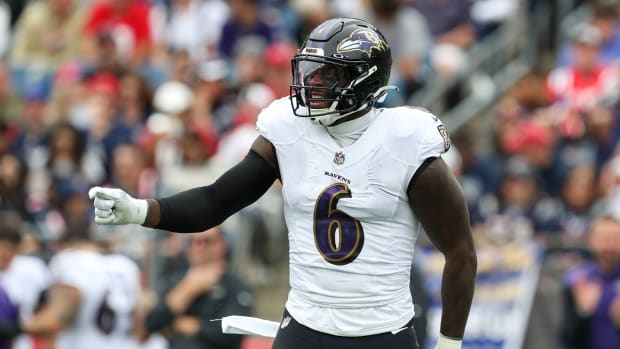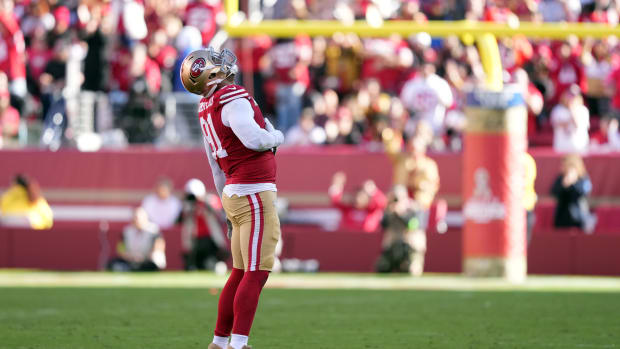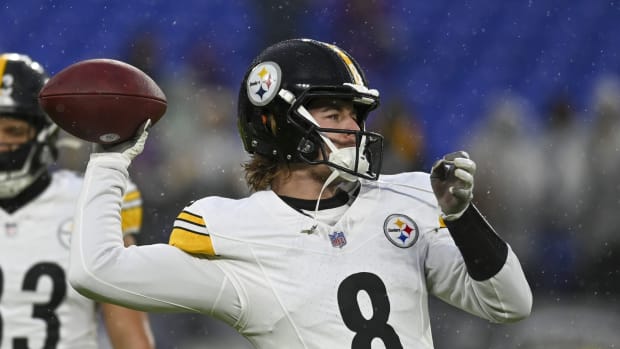Why Your Playoff Team Didn’t Reach XLVIII: NFC
For various reasons, Colin Kaepernick, Drew Brees, Cam Newton, Nick Foles and Aaron Rodgers won’t be vying for the Lombardi Trophy. (Getty Images/5)
In the past three weeks, the Super Bowl dreams ended for 10 teams. Here, we diagnose precisely how every NFC playoff loser—New Orleans, Carolina, Philadelphia, Green Bay and San Francisco—missed out on an early February trip to New Jersey. (The AFC version can be viewed here.)
New Orleans Saints
Perhaps it was their mistakes in December, rather than ones made in January, that felled the Saints. Three losses in the final month of 2013 prevented them from gaining home-field advantage in the postseason. After all of their insistence about being a dangerous offense away from the Superdome, the Saints couldn’t handle the heavy rain and wind at a raucous CenturyLink Field on Jan. 11.
Tight end Jimmy Graham had just one catch for eight yards in a 23-15 divisional round loss to the Seahawks. (Joshua Weisberg/Icon SMI)
But had Mother Nature been more friendly, would the outcome have changed? This 23-15 divisional round loss closely resembled the Saints’ trip to the Pacific Northwest on Dec. 2, when it was a calm, cloudy 41 degrees and the Seahawks kicked their tails, 34-7. The only difference this time was that the Saints, who had run very effectively out of multi-tight end sets at Philadelphia in the wild-card round, maintained their newfound commitment to a base running game. But it didn’t produce against the Seahawks’ rested, athletic front seven, not to mention two of the league’s fiercest run-defending safeties, Kam Chancellor and Earl Thomas.
And, once again, neither did the Saints’ vaunted passing attack, even though coach Sean Payton featured a handful of new formation wrinkles. The Seahawks played their usual three-over, four-under hybrid press-man/zones and had no trouble recognizing the Saints’ route designs. When right guard Jahri Evans wasn’t getting abused by nickel defensive tackle Michael Bennett, Drew Brees was throwing off-target or having his passes broken up by the Legion of Boom’s tremendous physicality and impeccable timing. Jimmy Graham was held catchless for most of the game not because he was doubled (he rarely was) but because he, like the rest of the Saints’ receivers, was thoroughly outplayed. There was no pre-snap motion or stack release concept crafty enough to help the Saints receivers overcome suffocating corners Richard Sherman and Byron Maxwell, who both operated with no safety help over the top. This allowed Seattle’s other defenders to condense the interior of the field, the focal point for most of New Orleans’ passing game.
After two trips to Emerald City, it’s crystal clear: the Seahawks’ defense is better than the Saints’ offense. Too bad for the Saints; their perennially so-so defense was actually excellent in this game.
Carolina Panthers
Despite ranking 11th in rushing yards, the Panthers never had a strong base running game in 2013. They relied on a lot of misdirection concepts and Cam Newton’s play-making ability. This caught up to them in the postseason; outside the red-zone, they didn’t even consider pounding the ball against the 49ers’ formidable front seven. Top back DeAngelo Williams had just five carries for 13 yards in a 23-10 divisional round loss. Inside the red-zone, the Panthers couldn’t get movement at the point of attack and came away with three total points on three trips.
Steve Smith’s ailing knee hurt the Panthers in the second half of a 23-10 loss to the 49ers in the divisional round. (Jeff Siner/Charlotte Observer/MCT/Sipa USA)
The Panthers’ passing attack also screeched to a halt in the second half as Steve Smith’s bum knee grew progressively worse. Early on, when Smith was fluid and spry, Newton was tremendous with tight, well-timed, deep-intermediate throws from the pocket. Offensive coordinator Mike Shula helped Newton get comfortable by having him run early on. That, however, added to the young quarterback’s hit totals, which started taking a toll late in the second half, when Carolina’s O-line had trouble with the sheer strength of San Francisco’s front. The Niners used intentionally slower mush-rushes to keep Newton from scrambling outside the pocket. With this, plus Smith being ineffective, the ancillary receivers were unable to get open and Newton couldn’t get a clear picture as a continuous drop-back passer.
These things happen when you face a top defense. The Niners, typically a man-based defense, did a great job of incorporating inside zone concepts to help keep eyes on Newton. That created the added bonus of crowding the seams. Both of Newton’s interceptions came near this region of the field, and each time his intended receiver was blanketed by an underneath defender while another defender made a play over the top.
All of Carolina’s weaknesses on offense rose to the surface, and their usual strengths—including their creative backfield screen game, which they eschewed presumably due to the speed and awareness of the 49ers’ linebackers—were stifled. Carolina’s defense can typically compensate for this, but it was unable to get off the field. San Francisco’s final three drives averaged 5 ½ minutes and 10 plays.
Philadelphia Eagles
Playing man-to-man with minimal safety help, Saints cornerback Keenan Lewis took away DeSean Jackson, the Eagles’ No. 1 wideout, which allowed Lewis’s teammates to focus on running back LeSean McCoy and hunt down Philadelphia’s misdirection and crossing patterns. There was no rhythm to the Eagles’ passing attack, which forced Nick Foles to hold onto the ball longer and made him less and less comfortable in this wild-card matchup.
DeSean Jackson had only three receptions for 53 yards in a 26-24 wild-card loss to New Orleans. (Laurence Kesterson/UPI/LANDOV)
It was shrewd of Saints defensive coordinator Rob Ryan to not blitz very often. When you blitz, you give the quarterback an opportunity to throw a defined hot route. When you play coverage, you force the quarterback to make progression reads. Foles, because he takes such good care of the ball, is generally perceived to be an intelligent progression passer. But like most second-year quarterbacks, the reality is that he relies on his system and needs to have his progressions limited to two, maybe three, depending on the route designs.
The Eagles’ offense still posted a respectable 24 points. Unfortunately their defense, which had allowed more than 22 just once since late September, surrendered 26. Most disappointing, they actually won the battle against Drew Brees and the Saints’ passing attack. They employed outside linebacker Connor Barwin as a press-jam defender and underneath helper in coverage, disrupting New Orleans’ timing and mid-level spacing. Brees had 250 yards, one touchdown, two interceptions and, though under minimal pressure most of the night, he was sacked twice.
The problem was the inability of the Eagles’ front seven to make stops against the run. In the second half, and on every play of the game-winning field goal drive, the Saints went with multi-tight end personnel and often pounded the rock. Running backs Mark Ingram and Khiry Robinson got stronger as the game progressed. Having not played much in the regular season, they had fresh legs against a defense that registered more snaps (71.9 per game) than any since the ’99 Browns and was just six days removed from a hard-fought Sunday night road game at Dallas in the regular-season finale. The running backs’ 142 combined yards on 26 carries were enough to send the Eagles on vacation.
Green Bay Packers
After watching this game on television, many of the nerdiest football aficionados came away asking, Why in the world did the Packers play “two-man” and allow Colin Kaepernick to once again scramble for big yardage against defenders who often had their backs to the line of scrimmage? But the coaches film revealed that Packers defensive coordinator Dom Capers actually had his men in a lot of zone concepts, sometimes even with a spy on Kaepernick. San Francisco’s stretched formations, and at times Green Bay’s poor pass-rush lane discipline, created large voids for the quarterback to bound through like a deer. It was a classic case of an offense out-leveraging and out-playing the defense. To be fair, it was a defense that was ravaged by injuries at outside linebacker (including tar Clay Matthews) and had to replace top cover corner, Sam Shields, with rookie Micah Hyde, who blew a man coverage assignment on Anquan Boldin to set up a Niners’ touchdown; Hyde also dropped an interception that led to a 49ers’ field goal.
Rookie Micah Hyde dropped a sure interception that led to a Niners’ field goal in a 23-20 wild-card loss. (Mike Roemer/AP)
Things weren’t rosy on the other side, either, in Green Bay’s 23-20 wild-card loss. The same problem that plagued the Packers in their 2011 divisional round loss to the Giants showed up again: their inability to block a potent four-man pass rush without overloading their protections. More than that, though, was the poor play at quarterback. Aaron Rodgers—the Canton-bound Rodgers—was terrible. He was jittery in the pocket, choppy as he transitioned from one progression to the next, and often not sharp when finally uncorking the ball. Rodgers might have been playing just his second game since returning from a broken left collarbone, but he still made a few spectacular improvised plays. Ultimately, he gave the offense no flow, which is what you need against the 49ers’ defense.
San Francisco 49ers
Colin Kaepernick was exactly who we thought he was. He made extraordinary plays with his legs to help the Niners overcome their suddenly impotent rushing attack in the NFC title game, and, though proficient late in the down a few times through the air, he ultimately failed to deliver in crucial must-throw situations. Two of Kaepernick’s second-half turnovers partly resulted from good defense by the Seahawks. The sack-fumble was caused by defensive tackle Michael Bennett burning right guard Alex Boone off the snap, and by defensive end Cliff Avril getting by right tackle Anthony Davis on his second step. The game-sealing interception was an underthrown ball, but also a tremendous play by Richard Sherman (just ask him). Sandwiched between those turnovers was Kaepernick’s interception to Kam Chancellor, which might have been the most bizarrely blatant mistake of the 2013 season.
Kaepernick pinned the loss on himself, but that’s too harsh. San Francisco and Seattle both came in having leaned on their terrific rushing attacks. Only Seattle’s showed up. While Frank Gore was stymied, Marshawn Lynch became the first player to rush for 100 yards against San Fran’s voracious D since Dec. 22, 2012. (The last player to do it? Beast Mode himself.) In the passing game, the Niners confused Russell Wilson with selective blitz calls, but they had two crucial breakdowns when Wilson improvised. The first occurred when safeties Donte Whitner and Eric Reid let Doug Baldwin get over the top on the 51-yarder. The second was Aldon Smith jumping offside on 4th-and-7, the play that wound up being a beautiful 26-yard seam throw to Jermaine Kearse in the end zone. Add the three late turnovers and that’s five crucial 49ers’ mistakes made on the road against the NFC’s top seed. That’s how you avoid going to the Super Bowl.







































